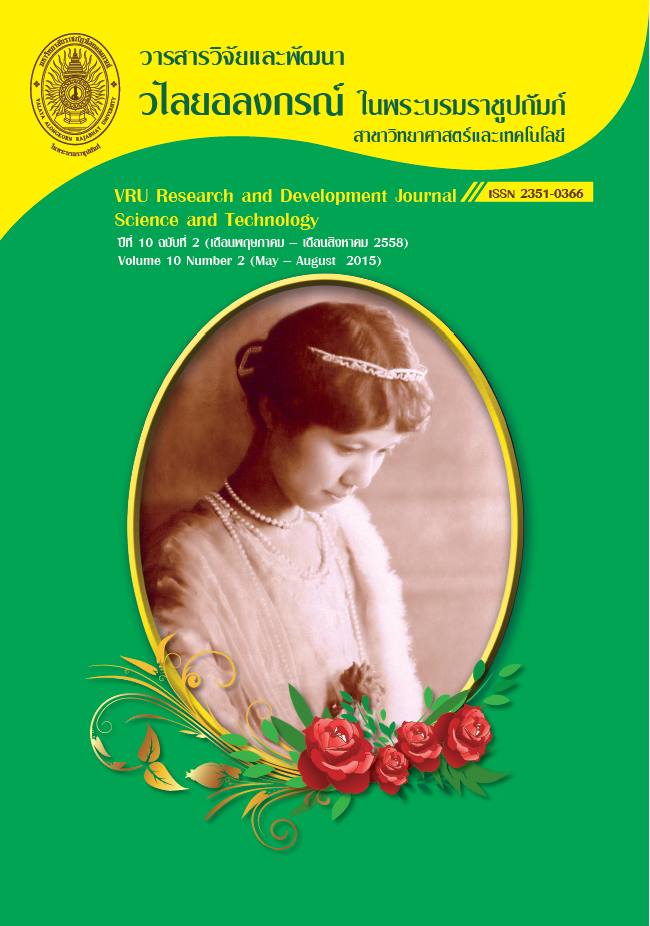การศึกษาการทนต่อยาปฏิชีวนะและยาฆ่าแมลงของ Sinorhizobium meliloti
Main Article Content
Abstract
Multidrug resistance efflux pumps (MDR) เป็นกลไกลที่สำคัญของแบคทีเรียซึ่งเกี่ยวข้องกับการขับสารที่เป็นพิษต่อเซลล์ออกจากเซลล์ทำให้แบคทีเรียนั้นๆ สามารถอยู่รอดในสภาวะที่ไม่เหมาะสมได้ สำหรับ Sinorhizobium meliloti ซึ่งเป็นแบคทีเรียที่พบได้ในดินและมีโอกาสที่จะสัมผัสกับสารพิษทั้งจากการเกษตรกรรมและอุตสาหกรรม MDR ก็เป็นกลไกหนึ่งซึ่งเกี่ยวข้องกับการป้องกันเซลล์จากสารที่เป็นพิษ ในการทดลองนี้ทำจะการทดสอบหาค่า minimal inhibition concentration (MIC) โดยทำการทดสอบกับ Sinorhizobium meliloti สายพันธุ์ดั้งเดิม และสายพันธุ์ที่ทำให้เกิดการเสียสภาพของยีน Smc03167 และ Smc03168 ซึ่งเป็นยีนที่พบว่ามีความเกี่ยวข้องกับ MDR ชนิดหนึ่งของ Sinorhizobium meliloti ซึ่งในการทดลองจะใช้ยาปฏิชีวนะทั้งหมด 6 ชนิดคือ tetracycline, chloramphenicol, nalidixic acid, neomycin, kanamycin และ carbonyl cyanide 3-chlorophenylhydrazone (CCCP) และใช้ยาฆ่าแมลงทั้งหมด 3 ชนิดคือ bentazol, chlorpyrifos และ pentachlorophenol ผลการทดลองพบว่า ค่า MIC มีความแตกต่างกันระหว่างสายพันธุ์ดั้งเดิมและสายพันธุ์ที่ทำให้เกิดการเสียสภาพของยีนเมื่อทำการทดสอบกับยาฆ่าแมลง แต่ไม่พบความแตกต่างระหว่างสายพันธุ์ดั้งเดิมและสายพันธุ์ที่ทำให้เกิดการเสียสภาพของยีนเมื่อทำการทดสอบกับยาปฏิชีวนะ
Downloads
Article Details
Copyright Notice
The copyright of research articles published in the VRU Research and Development Journal Science and Technology Journal belongs to the Research and Development Institute, Valaya Alongkorn Rajabhat University under the Royal Patronage. Reproduction of the content, in whole or in part, is prohibited without prior written permission from the university.
Responsibility
The content published in the VRU Research and Development Journal Science and Technology Journal is the sole responsibility of the author(s). The journal does not assume responsibility for errors arising from the printing process.
References
หนึ่ง เตียอำรุง และ นันทกรบุญเกิด. (2539). ความสัมพันธุ์ระหว่างไรโซเบียมกับพืชตะกูลถั่วในเชิงพันธุกรรมระดับโมโลกุล. วารสารเทคโนโลยีสุรนารี. 3: 15-20.
Alekshun M. N. and S. B. Levy. (2007). Molecular mechanisms of antibacterial multidrug resistance. Cell. 128: 1037-1050
Li X. Z. and Nikaido H. (2009). Efflux-mediated drug resistance in bacteria: an update. Drugs. 69: 1555-1623.
Borges-Walmsley et al. (2003). Structure and function of efflux pumps that confer resistance to drugs. Biochem. J. 376: 313-338.
Piddock J. V. (2006). Multidrug-resistance efflux pumps-not just for resistance. Microbiology. 4: 629-636.
Poole K., (2007). Efflux pumps as antimicrobial resistance mechanisms. Ann. Med. 39: 162-176
Konstantinidis KT. And Tiedje JM. (2004). Trends between gene content and genome size in prokaryotic species with larger genomes. P Natl Acad Sci USA. 101: 3160-3165
Martinez J. L. et al. (2009). Functional role of bacterial multidrug efflux pumps in microbial natural ecosystems. FEMS Microbiol. Rev. 33: 430-449.
Shima Eda. et al. (2011). Involvement of the SmeAB multidrug efflux pump in resistance to plant antimicrobials and contribution to nodulation competitiveness in Sinorhizobium meliloti. Applied and Environmental Microbiology. 77: 2855-2862.
Jingjing S. et al. (2014). Bacterail multidrug efflux pumps: Mechanisms, physiology and pharmacological exploitations. Biochemical and Biophysical Research Communications. 453: 254-267.
Lomovskaya 0. and K. Lewis. (1992). emr, an Escherichia coli locus for Multidrug Resistance. Proc. Natl. Acad. Sci. U.S.A. 89:8938-8942.
Furukawa H. et al. (1993). Thiolactomycin Resistance in Escherichia coli Is Associated with the Multidrug Resistance Efflux Pump Encoded by emrAB. J. Bacterid. 175:3723- 3729.
Li X. Z. et al. (1994). Role of efflux pump(s) in intrinsic resistance of Pseudomonas aeruginosa: resistance to tetracycline, chloramphenicol, and norfloxacin. Antimicrob. Agents Chemother. 38: 1732-1741.
Poole K. et al. (1993). Multiple antibiotic resistance in Pseudomonas aeruginosa: evidence for involvement of an efflux operon. J. Bacteriol. 175: 7363-7372.
Eaves D. J. et al. (2004). Expression of arcB, arcF, arcD, mprA and soxS in Samonella enterica serovar Typhimurium: role in multiple antibiotic resistance. Antimicrob. Agents. Chemother. 48: 1145-1150.
Pumbwe et al. (2004). Expression of the efflux pump genes cmeB, cmeF and the porin gene porA in multiply antibiotic resistant Campylobacter spp. J. Antimicrob. Chemother. 54: 341-347.
Ramon G. and Esperanza M. (2000). Multiresistance Genes of Rhizobium etli CFN42. Mol. Plant. Microbe Interact. 13:572-577.
Palumbo J. D. et al. (1998). An isoflavonoid inducible efflux pump in Agrobacterium tumefarciens is involvein competitive colonization of roots. J. Bacteriol. 180: 3107-3113.
Jocelyn et al. (2007). Transcriptome analysis reveals that Multidrug Efflux Genes are unregulated to protect Pseudomonas aeruginos from pentachlorophenol stress. Applied and environmental microbiology. 73: 4550-4558.
Wirongrong w. et al. (2010). ChrR is a Chlopyrifos-responsive transcription regulator in Sinorhizobium meliloti. J Mol Microbiology Biotechnol. 18:141-147.


